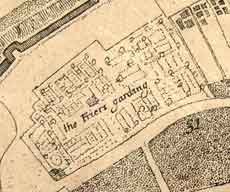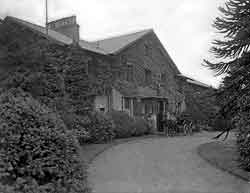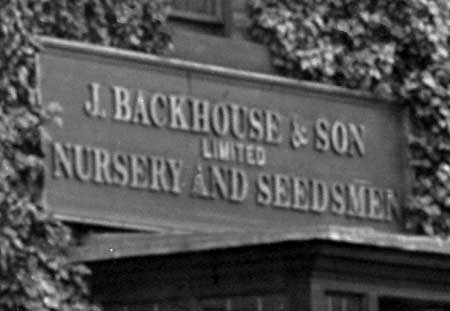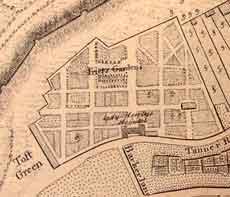The history of this once-famous Yorkshire nursery and its owners encapsulates many aspects of British culture and economics over a period of 200 years.
The founders were born in the 18th century and came from a widely connected Northern English Quaker family amongst whom were many keen botanists.
In the 19th century the nursery was famous in Britain and abroad as suppliers of trees, garden plants and seeds.
The botanising Backhouses
The Backhouse wealth came from linen manufacture and banking in Darlington, County Durham, where James Backhouse (1) (1721-98) founded the Backhouse Bank with his two sons Jonathan and James (2) (1757-1804).[1] It was the son of James (2),James Backhouse (3) who founded the Backhouse Nursery.
James was attracted to the nursery business for a number of reasons. He suffered from asthma and was often sent as a child for fresh country air to Quaker friends in nearby Teesdale, a place rich in wild flowers.[2] He had cousins and two uncles who were interested in botany, but perhaps the earliest influence on him was the inheritance at the age of 9 of his brother Nathan's herbarium, when Nathan died aged 17. James later wrote, ‘[his] herbarium falling into my hands first set me to study my botany'.[3] After school in Leeds he continued exploring Teesdale with local botanists.[4]
Starting in the nursery business
When James was 19 he was apprenticed for two years to Wagstaffe's Nursery in Norwich, an open-air career being thought good for his chest. He then visited nurseries in Scotland and in 1815 he and his brother Thomas Backhouse (1792-1845) were able to buy the nursery business of John and George Telford (or Tilford) in York, having found nothing suitable around Darlington. This firm had probably been established since around 1665 at Tanner Row, Toft Green, on ground granted to the Dominican Friars by various kings from 1228 onwards.
In 1736 a York historian wrote:
The site of this ancient monastery is now a spacious garden; at present occupied by Mr Tilford a worthy citizen, and whose knowledge in the mystery of gardening renders him of credit to his profession; being one of the first that brought our northern gentry into the method of planting and raising all kinds of trees for use and ornament.[5]

Figure 1. This detail from a 1697 map of York by Benedict Horsley shows the planting layout of Telford's Nursery at 'The Friers Garding' (Friar's Gardens) in York. Image courtesy of York City Library.
In referring to ‘our northern gentry' as having a nursery local to York, Drake would perhaps have been displaying some regional pride, as it was usual in the 18th century for wealthy people to have plants and trees sent up from London nurseries, or even from Holland, France and Italy. Edwin Lascelles of Harewood House, Yorkshire wrote slightingly of local nurseries' ability to provide unusual plants. In a letter from London to his steward Popplewell, he wrote: ‘I shal [his spelling] bring some Tube Roses roots. There is no depending upon country Nurserymen for any thing of this kind that is not quite common'.[6] Backhouses showed their ability to compete with London when, in 1819, they put an advertisement in the Yorkshire Gazette for ‘Choice BULBS of BELLA-DONNA and GUERNSEY LILIES'.[7]
The next generations
When he returned to York in 1841, James took up the running of the business, firstly with Thomas, who died in 1845 and then with his son James Backhouse (4) (1825-90).
Father and son were keenly interested in alpine plants and botanised together in Teesdale, in highland areas of Britain and on the continent.[12] With the coming of the railway the nursery had been moved to Fishergate, York and in 1853 was moved again to a 100-acre site (bigger than Kew!) at Holgate, York.[13]
James died in 1869 and his son carried on the business, later being joined by his own son James Backhouse (5) (1861-1945). It was in this period up to 1890 that the nursery was at the height of its fame and prosperity, importing plants, maintaining 40 greenhouses as well as an underground fernery, and a much-visited rockery that was famous for its huge cost and the attractive arrangement of its alpine plants.[14]
‘My first love of ferns was gained by a visit to the Fernery of Messrs. Backhouse of York'In the 18th century the wealthy elite had formed collections - for instance of art, archaeology, insects or rare plants - and developed their gardens. In Backhouse's time these interests were also apparent among middle-class and newly rich people, appealing, too, to the desire for compendious knowledge. The Backhouse nursery was able to display and sell ferns and alpines and an American visitor in 1890 wrote: ‘Nowhere, not even at Kew, is there so rich a collection of filmy ferns... Only the favoured are allowed to see it...'. James Backhouse (4) shared his botanical knowledge and possessions, supplying, for instance, specimen material for the author of an eight-volume work, who wrote in 1865: ‘My first love of ferns was gained by a visit to the Fernery of Messrs. Backhouse of York'.[15]

Entrance to the Holgate nursery, York. Image courtesy of Country Life Picture Library.

The J. Backhouse & Son Limited company sign above the entrance door at the Holgate nursery, detail from the exterior view of the entrance to the Holgate nursery, York. Image courtesy of Country Life Picture Library.
The troubled economic times that followed the Agricultural Depression of the 1880s, the 1910 Land Tax and the First World War all led to a reduction in the demand for trained gardeners and for costly and labour-intensive gardens and estate plantations. So, despite James (5) forming a new company in 1891, Backhouse Nurseries (York) Ltd., the firm suffered a loss of income over time, caused also by fierce competition from other nurserymen.
In 1921 much of their land was sold and the firm was closed in 1955.[16] The 28 acres of land left was bought by York City Corporation as a nursery and to make into a public park.[17] It is to be hoped that the Backhouse Nursery ledgers and account books, mentioned by Davis, may one day be located and provide us with more detail on the firm's history.[18]
From Toft Green to Australia
The Telford family were using the site as a plant nursery at this time, and this map indicates the layout of the planting. Image courtesy of York City Library.The land at Toft Green remained a nursery until the York railway station was built in 1841.[8] So the Backhouse brothers continued in the Telford tradition and could hardly have chosen a better time to become involved in such a business: their customers were wealthy from land ownership, trade with the colonies and from British manufacturing and their attendant service industries. They were keen to stock their gardens, greenhouses and estates. This was the time, too, when many horticultural societies and botanic and public gardens were founded and when the Royal Botanic Gardens at Kew grew to become the British empire's centre for the exchange of scientific information about plants.

Figure 2. The Friar's Gardens, detail from the 1766 map of York by Chassereau.
The development of the railways, in which the Backhouse family were also involved, helped many businesses to prosper. It was the marriage alliances of the Quaker Pease, Backhouse and Gurney families, with their ownership of banks in the North East and Norfolk, that produced enough capital to fund the early railway system (at the time mainly needed for the transport of coal from Newcastle).[9] For the Backhouse Nursery it meant that correspondence, plants and seeds could all be far more efficiently distributed. Previously, transport had been slow by horse and ship, often resulting in damage to plants.
Plantations Undertaken by the acreThe nursery purchase was advertised in the York Courant of 13 May 1816 by each firm.[10] The 1821 catalogue, apart from listing the great variety of trees, shrubs and perennial plants, including culinary and ‘Aquaticks' and gardening tools, advertises two other services often supplied by British nurseries: ‘Plantations Undertaken by the acre' and ‘Gentlemen supplied with experienced Gardeners'.
James's married life was cut short by the death of his wife of five years in 1827, leaving him with two small children. Despite this he felt confident enough to leave them and the business in the care of his family in order to sail for Australia in 1831 to continue with his Quaker missionary work. He was away for 10 years, returning home via Mauritius and South Africa. But, being a keen botanist, he naturally collected plants and seeds to send back both to his nursery and to his friend from Norwich days, William Hooker , by now Professor of Botany at Glasgow University .[11]
Endnotes
- Davis, P., ‘Backhouse Family (per. C. 1770-1945), naturalists and horticulturalists' in The Oxford Dictionary of National Biography. oxforddnb.com [accessed 14 March 2008].
- Davis, P., "James Backhouse of York (1794-1869): missionary, traveller and botanist" in Archives of Natural History (1989) 16 (3), p247.
- Davis, 1989, p247.
- See separate article on James Backhouse (3) .
- Drake, F., Eboracum: or the history and antiquities of the City of York, W. Bowyer, London 1736, republished by E.P. Publishing Limited, 1978, with a new introduction by K.J. Allison, p274.
- Letter of 27 April 1758 in the Archive of the Earls of Harewood, WYL250/3/SC/2/2/102.
- Yorkshire Gazette, 11 September 1819.
- Davis 1989, p250; Pugh, R.B., ed., Victoria County History; City of York, University of London, 1961, p362-3. See Figure 1: 1697 map of York showing The Friers Garden
- Kirby, M.W., ‘Backhouse, Jonathan (1779-1842) banker and financier' in The Oxford Dictionary of National Biography. oxforddnb.com [accessed 14 March 2008].
- Advertisements on the front page of the York Courant of 13 May, 1816, at the time of the sale of Telfords’ nursery to the Backhouse brothers.
- Davis, 1989, p251.
- Davis, Oxford DNB.
- Davis 1989, p256.
- Davis 1989, p256.
- Quoted in Davis, 1989, p256-7.
- Davis, Oxford DNB.
- Davis, 1989, p257.
- Davis 1989, p256.
Articles
Davis, P., ‘Backhouse Family (per c.1770-1945)', in The Oxford Dictionary of National Biography. www.oxforddnb.com [accessed 14 March 2008].
Davis, P., ‘The Backhouse Family, Bankers and Horticulturalists, Durham County Local History Society, durhamweb.org.uk [accessed 14 March 2008].
Davis, P., ‘James Backhouse of York (1794-1869): missionary, traveller and botanist', Archives of Natural History, 16.3 (1989), 247-60.
FitzGerald, Sylvia, ‘Hooker, Sir William Jackson (1785-1865) botanist', in The Oxford Dictionary of National Biography. www.oxforddnb.com [accessed 14 March 2008].
Kirby, M.W., ‘Backhouse, Jonathan (1779-1842) banker and financier' in The Oxford Dictionary of National Biography. www.oxforddnb.com [accessed 14 March 2008].
Davis, P., ‘Backhouse Family (per c.1770-1945)', in The Oxford Dictionary of National Biography. www.oxforddnb.com [accessed 14 March 2008].
Davis, P., ‘The Backhouse Family, Bankers and Horticulturalists, Durham County Local History Society, durhamweb.org.uk [accessed 14 March 2008].
Davis, P., ‘James Backhouse of York (1794-1869): missionary, traveller and botanist', Archives of Natural History, 16.3 (1989), 247-60.
FitzGerald, Sylvia, ‘Hooker, Sir William Jackson (1785-1865) botanist', in The Oxford Dictionary of National Biography. www.oxforddnb.com [accessed 14 March 2008].
Kirby, M.W., ‘Backhouse, Jonathan (1779-1842) banker and financier' in The Oxford Dictionary of National Biography. www.oxforddnb.com [accessed 14 March 2008].
Primary sources
T. & J. Backhouse catalogue, 1821 (Linnean Society of London, photocopy in York City Library).
Archive of the Earls of Harewood, West Yorkshire Archives Service, Leeds.
Books
- Drake, F., Eboracum: or the history and antiquities of the City of York, (London: W. Bowyer, 1736) Republished by E.P. Publishing Limited, 1978, with a new introduction by K.J. Allison
- Pugh, R.B., ed., Victoria County History; City of York (University of London, 1961)
- Wilson, V., Beyond the Postern Gate: A History of Fishergate and Fulford Road (York: Archaeological Resource Centre, 1996).
